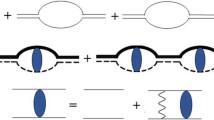Abstract
Nuclear reaction theory, such as deuteron-alpha radiative capture, has been an essential part of developing nuclear physics. This reaction is the only process that leads to the production of \(^6\)Li. The deuteron-alpha radiative capture reaction has been investigated under the framework of Effective Field Theory, up to next to leading order (NLO). In this study, alpha particles were considered structureless and the Coulomb effects were assumed as a Coulomb correction for \(E_1\) and \(E_2\) electric multipole transitions, up to NLO. By inserting three-body forces, the scattering amplitude was computed at the initial state of the deuteron-alpha P-wave for the sum of both multipole transitions \(E_1\) and \(E_2\). Two of the low-energy photonuclear observables, including the astrophysical S-factor and reaction rate of deuteron-alpha radiative capture reaction, are calculated. The calculated photonuclear observables are in satisfactory agreement with the other theoretical methods and the available experimental data, with energies relevant to Big-Bang Nucleosynthesis.







Similar content being viewed by others
References
Anders M, Trezzi D, Menegazzo R (2014) \(S\)-factor measurement of the \(d(\alpha,\gamma )^6Li\) reaction at energies relevant for Big-Bang nucleosynthesis. Phys Rev Lett 113:042501
Angulo C et al (1999) A compilation of charged-particle induced thermonuclear reaction rates. Nucl Phys A 656:3
Baye D, Tursunov EM (2018) Isospin-forbidden electric-dipole capture and the \(\alpha (d, \gamma ) ^6Li\) reaction. J Phys G Nuclear Phys 45:8
Bedaque PF, van Kolck U (2002) Effective field theory for few-nucleon systems. Annu Rev Nuclear Particle Sci 52:339
Burkova NA (1990) Is it possible to observe an isoscalar-multipole in \(d +\alpha \longrightarrow ^6Li + \gamma\) reactions? Phys Lett B 248:15
Flowers BH, Mandl F (1951) Inverse Processes Photodisintegration of the alpha-particle and the inverse processes. Proc R Soc 0060:131–144206
Grassi A, Mangano G, Marcucci LE, Pisanti O (2017) The \(\alpha + d \longrightarrow ^6Li + \gamma\) astrophysical S-factor and its implications for Big Bang Nucleosynthesis. Phys Rev C 96:045807
Hammer HW, Konig S, van Kolck U (2019) Nuclear effective field theory: status and perspectives. arXiv:1906:12122v1
Hofmann HM, Fick D (1970) Three-body calculations of elastic deuteron-helium 4-scattering with Faddeev equations. Zeitschrift fr Physik A Hadrons and nuclei 240:420
Kiener J (1991) Measurements of the Coulomb dissociation cross section of \(156\) MeV projectiles at extremely low relative fragment energies of astrophysical interest. Phys Rev C 44:2195
Lehman DR, Mamta R (1982) Alpha-deuteron structure of Li as predicted by three-body models. Phys Rev C 25:2743
Mohr C et al (1994) Direct capture in the 3+ resonance of H2 (\(\alpha\), \(\gamma\)) 6 Li. Phys Rev C 50:1543
Nahidinezhad S, Sadeghi H, Khalili H (2020) \(d-\alpha\) Radiative capture process by effective field theory. New Astron 80:101424
Nahidinezhad S, Sadeghi H, Khalili H (2020) Astrophysical \(S\)-factor of the \(d(\alpha ,\gamma )^6Li\) process by effective field theory. Astrophys Space Sci 365:74
Nahidinezhad S, Sadeghi H, Khoddam M (2021) Reaction rate calculation of \(d(\alpha,\gamma )^6Li\) process at low energy in framework of effective field theory. New Astron 82:101461
Navratil P, Quaglioni S (2011) Ab initio many-body calculations of deuteron-\(^4He\) scattering and \(^ 6Li\) states. Phys Rev C 83:044609
Nollett KMM, Wiringa RB, Schiavilla R (2001) A six-body calculation of the deuteron-alpha radiative capture cross section. Phys Rev C 63:024003
Robertson RG, Dyer P, Melin RC, Bowles TJ, Mcdonald AB, Ball GC, Davies WG, Earle ED (1984) The upper limit on the isovector parity-violating decay width of the T = 1 state of. Phys Rev C 29:755
Ryzhikh GG, Eramzhyan RA, Shlomo S (1995) \(\alpha\)-\(d\) capture with formation of \(^6Li\) and the isoscalar multipole. Phys Rev C 51:3240
Sadeghi H (2007) Neutron-deuteron system and photon polarization parameter at thermal neutron energies. Phys Rev C 75:044002
Sadeghi H (2010) Triton electric form factor at low-energies. Prog Theor Phys 124:1037
Sadeghi H, Bayegan S (2005) \(Nd \longrightarrow ^3H\gamma\) with effective field theory. Nucl Phys A 753:291
Sadeghi H, Bayegan S (2010) Triton photodisintegration with effective field theory. Few Body Syst 47:167
Sadeghi H, Bayegan S, Grießhammer HW (2006) Effective field theory calculation of nd radiative capture at thermal energies. Phys Lett B 643:263
Shanley PE (1968) Three-body calculation of deuteron-alpha scattering and polarization. Phys Rev Lett 21:627
Thapaliya A, Ji C, Phillips D (2016) Halo effective field theory of \(^6He\). EPJ Web Conf 113:08018
Trezzi D et al (2017) Big Bang \(^6Li\) nucleosynthesis studied deep underground (LUNA collaboration). Astroparticle Phys 89:57
Tursunov EM, Kadyrov AS, Turakulov SA, Bray I (2016) Theoretical study of the \(d + \alpha \longrightarrow ^6Li + \gamma\) astrophysical capture process in a three-body model. Phys Rev C 94:015801
Tursunov EM, Turakulov SA, Kadyrov AS, Bray I (2018) Theoretical study of the direct \(d + \alpha \longrightarrow ^6Li + \gamma\) astrophysical capture process in a three-body model II: reaction rates and primordial abundance. Phys Rev C 98:055803
Tursunov EM, Turakulov SA, Kadyrov AS (2020) Comparative study of the direct \(\alpha + d \longrightarrow ^6Li+\gamma\) astrophysical capture reaction in few-body models. Nucl Phys A 1000:121884
Vanasse J (2018) Charge and magnetic properties of three-nucleon systems in pionless effective field theory. Phys Rev C 98(3):034003
Xu Y, Takahashi K, Gorielya S, Arnould M, Ohtac M, Utsunomiya H, (NACRE II Collaboration), (2013) NACRE II: an update of the NACRE compilation of charged-particle-induced thermonuclear reaction rates for nuclei with mass number \(A<16\). Nucl Phys A 918:61
Funding
The authors have not disclosed any funding.
Author information
Authors and Affiliations
Corresponding author
Ethics declarations
Conflict of interest
The authors have not disclosed any competing interests.
Rights and permissions
Springer Nature or its licensor (e.g. a society or other partner) holds exclusive rights to this article under a publishing agreement with the author(s) or other rightsholder(s); author self-archiving of the accepted manuscript version of this article is solely governed by the terms of such publishing agreement and applicable law.
About this article
Cite this article
Sadeghi, H., Nahidinezhad, S. The \(d-\alpha\) Radiative Capture Process Reaction Rate with Three-Body Forces. Iran J Sci 47, 315–322 (2023). https://doi.org/10.1007/s40995-022-01405-3
Received:
Accepted:
Published:
Issue Date:
DOI: https://doi.org/10.1007/s40995-022-01405-3




